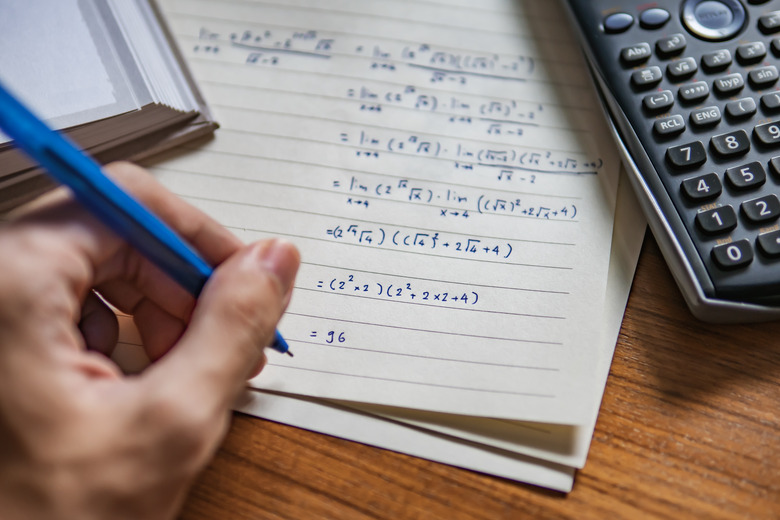How To Use Algebra 2 In Real Life
Many students resent having to learn algebra in high school or college because they don't see how it applies to real life. Yet, the concepts and skills of Algebra 2 provide invaluable tools for navigating business solutions, financial problems and even everyday dilemmas. The trick to successfully using Algebra 2 in real life is determining which situations call for which formulas and concepts. Luckily, the most common real life problems call for widely applicable and highly recognizable techniques.
Step 1
Use quadratic equations to find the maximum or minimum possible value of something when increasing one aspect of the situation decreases another. For instance, if your restaurant has a capacity of 200 people, buffet tickets currently cost $10, and a 25 cent increase in price loses about four customers, you can figure out your optimum price and maximum revenue. Because revenue equals price times the number of customers, set up an equation that would look something like this: R = (10.00 + .25X)(200 – 4x) where "X" represents the number of 25 cent increases in price. Multiply the equation out to get R = 2,000 -10x + 50x – x^2 which, when simplified and written in standard form (ax^2 + bx + c), would look like this: R = – x^2 + 40X + 3,000. Then, use the vertex formula (-b/2a) to find the maximum number of price increases you should make, which, in this case, would be -40/(2)(-1) or 20. Multiply the number of increases or decreases by the amount for each and add or subtract this number from the original price to get the optimum price. Here the optimum price for a buffet would be $10.00 + .25 (20) or $15.00.
Step 2
Use linear equations to determine how much of something you can afford when a service involves both a rate and a flat fee. For instance, if you want to know how many months of a gym membership you can afford, write out an equation with the monthly fee times "X" number of months plus the amount the gym charges up front to join and set it equal to your budget. If the gym charges $25/month, there is a $75 flat fee, and you have a budget of $275, your equation would look like this: 25x + 75 = 275. Solving for x tells you that you can afford eight months at that gym.
Step 3
Bring together two linear equations, called a "system," when you need to compare two plans and figure out the turning point that makes one plan better than the other. For example, you could compare a phone plan that charges a flat fee of $60/month and 10 cents per text message with one that charges a flat fee of $75/month but only 3 cents per text. Set the two cost equations equations equal to each other like this: 60 + .10x = 75 + .03x where x represents the thing that might change from month to month (in this case number of texts). Then, combine like terms and solve for x to get approximately 214 texts. In this case, the higher flat rate plan becomes a better option. In other words, if you tend to send less than 214 texts per month, you're better off with the first plan; however, if you send more than that, you're better off with the second plan.
Step 4
Use exponential equations to represent and solve savings or loan situations. Fill in the formula A= P (1 +r/n)^nt when dealing with compound interest and A = P(2.71)^rt when dealing with continuously compounded interest. "A" represents the total amount of money with which you will end up or will have to pay back, "P" represents the amount of money put into the account or given in the loan, "r" represents the rate expressed as a decimal (3 percent would be .03), "n" represents the number of times interest is compounded per year, and "t" represents the number of years the money is left in an account or the the number of years taken to pay back a loan. You can calculate any one of these parts by plugging in and solving if you have the values for all of the others. Time is the exception because it is an exponent. Therefore, to solve for the amount of time it will take to amass, or pay back, a certain amount of money, use logarithms to solve for "t."
TL;DR (Too Long; Didn't Read)
If you cannot immediately identify the type of equation involved, then attack the real life situation from scratch by converting words and ideas to numbers. When writing an equation from words, refrain from copying down each part of the problem or situation in order. Instead, stop and think about the numbers and unknowns. How do they relate to each other? Which values would you expect to be larger or smaller? Use this common sense when writing out the equation. When in doubt, draw a picture or graph. This will help you brainstorm ways to set up an equation that fits the situation.
Cite This Article
MLA
White, Kathryn. "How To Use Algebra 2 In Real Life" sciencing.com, https://www.sciencing.com/use-algebra-real-life-5714133/. 4 December 2009.
APA
White, Kathryn. (2009, December 4). How To Use Algebra 2 In Real Life. sciencing.com. Retrieved from https://www.sciencing.com/use-algebra-real-life-5714133/
Chicago
White, Kathryn. How To Use Algebra 2 In Real Life last modified August 30, 2022. https://www.sciencing.com/use-algebra-real-life-5714133/
